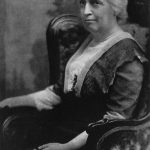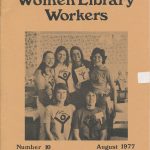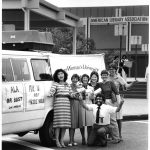
There are several units within the American Library Association that support women in the library profession and as a whole. Many of these groups arose during the second wave of feminism in the 1960s-80s in response to political and social movements outside of the ALA. Women in librarianship wanted the predominately-female profession to be regarded with the same respect and pay scale as other professions as well as more equity in ALA leadership.
One of the first major committees that is still around today is the Committee on the Status of Women in Librarianship (COSWL). This committee came about after several years of advocating by ALA members and the eventual approval at the 1976 Centennial Conference in Chicago.[1] Initially, a proposal was presented during the 1974 Annual Conference[2] and then discussed by Council during the 1975 Midwinter Meeting.[3] The ALA Executive Board endorsed a set of guidelines put forward in 1976, drafted by a standing committee appointed by the ALA president.[4] The committee has a list of seven responsibilities, all of which support the growth of women inside and outside of the field of librarianship. COSWL also sponsors several research projects, publications, and subcommittees related to women in libraries, such as the Advance Women in Library Management, Minority Women Oral History Project, and the COSWL Study. ALA currently maintains a list of resources on the COSWL homepage related to women’s issues.

Another ALA advocacy group that emerged in the 1980s is the Women’s Studies Section (WSS), now the Women & Gender Studies Section (WGSS), part of the ALA’s Association of College & Research Libraries (ACRL). This group “was formed to discuss, promote, and support women’s studies collections and services in academic and research libraries.”[5] In one of the section’s first newsletters published in spring 1987, co-editor Deb Schnieder wrote, “The Women’s Studies Section has finally arrived and I would like to take this opportunity to welcome all of you who have joined the section.”[6] In the following newsletter, 1987-88 Chair Ellen Broidy wrote:
“ACRL Women’s Studies Section is creating its own form of earthshaking; the world (in this instance the insular world of ACRL) will never quite be the same. Our recent transformation from discussion group to section (a bureaucratic paper pushing) has brought, along with an increase in family from 50 E. Huron St., an increased visibility that should serve us well as we continue our efforts to insure a place for Women’s Studies in academic libraries… The impact we make on the larger association depends in large measure on our desire to articulate and act upon our feminist principles. The clearest way we have of doing that, particularly in an organizational context, is to continue to provide a place for Women’s Studies librarians and others to feel safe, challenged, and connected.”[7]
In addition to newsletters, WSS also published a Women’s Studies Collection Development Policies in 1992, which was a project of the Collection development and Bibliography Committee as well, which sought to assist libraries facing the challenge of budge constraints and the, at the time, relatively new field of Women’s Studies.

There were and are several other groups within ALA that focus on women, such as the Feminist Task Force and the Social Responsibilities Round Table (SRRT). These groups put out a series of publications that addressed issues of women in libraries, such as the Women Library Workers: We Become New, a “national newsletter of an independent organization of women library workers which was formed during the 1975 ALA Convention in San Francisco.”[8] Other publications include the Status of Women in Librarianship Newsletter, Task Force on Women Newsletter, and Women in Libraries.

The records and publications of many of these groups are housed at the ALA Archives at the University of Illinois. Their place in the archives allows for the preservation of the historical record of the activism and advocacy for women created in ALA. The University of Illinois’s Gender Studies and Multicultural Services Librarian Cindy Ingold used documents from inside the ALA Archives for her online project, “How Did Women’s Groups in the American Library Association Promote Activism around Women’s Issues in Librarianship during the 1970s?” and is a great example of how primary sources within the archives fit together for greater meaning, and how the records of these organizations stretch beyond the purpose in which they were created. If you are interested in using materials from the archives for your own research, please contact the archives at ala-archives AT library.illinois.edu.
[1] The ALA Yearbook 1977, p.106. Record Series 2/4/72.
[2] School Library Journal, 23(5), Jan. 1977, p.35.
[3] The ALA Yearbook 1976, p.148. Record Series 2/4/72.
[4] American Libraries, 7(6), June 1976, p.311. American Libraries, 7(3), March 1976, p.138.
[5] http://www.libr.org/wgss/.
[6] Women’s Studies Newsletters, 1986, Record Series 22/23/10, American Library Association Archives.
[7] Women’s Studies Newsletters, 1986, Record Series 22/23/10, American Library Association Archives.
[8] Women Library Workers Publications, 1970-1989, Record Series 49/45/10, American Library Association Archives.